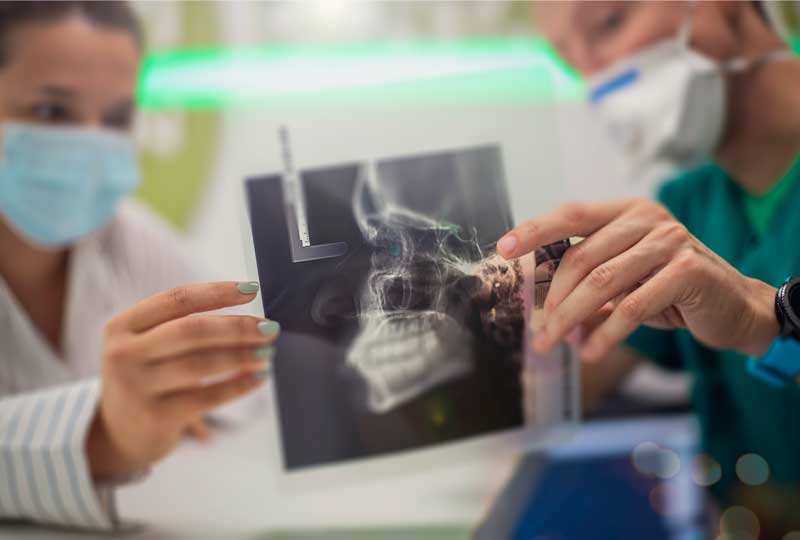Learn the details about preparation, procedure and recovery for corrective jaw surgery.
Orthognathic surgery corrects overbite, underbite, asymmetric jaw development and other issues that affect jaw function. There’s a lot to consider when it comes to the procedure, including the time commitment involved with pre-surgical treatment and post-surgical recovery. We asked Susie Lin, D.D.S., M.D., of Vanderbilt’s Oral and Maxillofacial Surgery, to walk us through the timeline and logistics of orthognathic surgery and what patients need to know.
Initial consultation
A patient who is considering orthognathic surgery should have a consultation with an orthodontist, as well as an oral and maxillofacial surgeon who has extensive training in jaw procedures.
“This initial consultation is very important,” Lin said, “and that may include obtaining some dental molds, radiographs and facial photos. From there, we do a very detailed analysis of the face and the jaw. And based on these records we formulate a treatment plan. Then we work with the orthodontist to work towards correcting these malocclusions and jaw disharmonies.”
Pre-surgical treatment
Many patients require pre-surgical orthodontic treatment prior to jaw surgery to correct any overcrowding of the teeth or other issues. “That’s going to help us be able to align the teeth during surgery,” Lin explained. Some patients only require braces for six months, Lin said, while others need them for two to three years beforehand.
A patient with impacted wisdom teeth will need to undergo wisdom teeth extraction about six to nine months prior to orthognathic surgery to allow for full healing. However, Lin said that sometimes wisdom teeth can be removed during the actual orthognathic surgery.
Additional consultations
During the pre-surgical phase, patients will still meet with their surgeon about every six months. “During these visits,” Lin said, “we sometimes obtain dental models and check radiographs just to make sure the teeth are being aligned in a way that’s going to help us during surgery and also to make sure facial growth has stabilized.”
Final records
Once the pre-surgical orthodontic period is complete, the orthodontist will have placed surgical wires on the teeth one to two weeks prior to surgery. The patient is then ready for what’s called the final record. “We discuss the surgical plans, and we obtain CT imaging and dental records,” Lin explained. “We do a planning session called computer-aided simulation or virtual surgical planning (VSP).” This allows the surgeon to have surgical positioning splints fabricated to help with the proposed surgical movements.
Day of surgery
Typically, orthognathic surgery is scheduled early in the day because it may take from four to eight hours to complete, depending on how extensive the procedure. The surgery is performed under general anesthesia, and patients usually stay in the hospital afterward for one to two nights.
Recovery phase
Pain is initially controlled in the hospital via a combination of IV medications and oral liquid pain medications, then patients are transitioned to oral pain medication prior to discharge. Patients will be given at-home recovery instructions. Often these instructions include keeping the air humidified, using specific nasal sprays to ease congestion, wearing guiding rubber bands and keeping stitches clean.
“Most patients start with a clear liquid diet,” Lin said. “But that can be advanced fairly quickly to a full liquid diet, or puréed diet, within days.” Then after the osteotomy sites heal in about six or seven weeks, patients can return to a regular diet.
Although mild activities are fine, Lin said patients should avoid strenuous activities until after getting clearance from their surgeon, which usually occurs after the six-week period.
Post-surgical treatment
Most patients will still have their braces on for the purpose of supporting guiding elastics during the healing period, Lin said. But some will keep braces on for a short period of post-operative orthodontic treatment, as well. Eventually a patient will get their braces off and wear a retainer instead.
And patients will still continue to check in with their surgeon. “We still follow these patients for about two years after surgery,” Lin said, “especially for patients who are still growing.”

Vanderbilt’s oral and maxillofacial surgeons care for people with complex injuries, diseases or deformities of the jaws and face. The team has the expertise to manage or repair a wide variety of problems, with a goal of reducing pain and providing better quality of life. For an appointment, call 615-322-2377.

